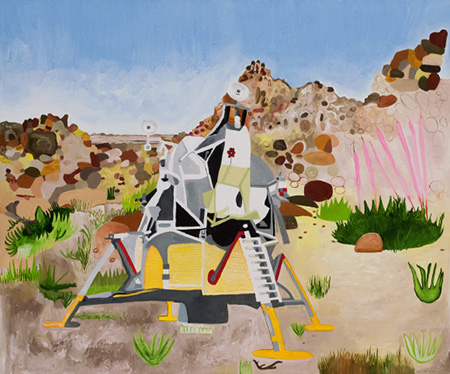
Continuing through May 9, 2015
For her current exhibition self-taught artist Carol Es brings together a series of mixed-media collage works and a series of paintings titled “Abstracted Desert Landscapes.” These two-dimensional works display many of the stylistic characteristics that the Los Angeles-based artist has developed over the course of her career: dark rough outlines, pre-printed fabrics, a penchant for bright colors formed into uneven shapes with occasional drips running down the picture plane. The artist’s patchwork techniques are rooted in the experiences of her troubled childhood, which included working long hours with her brother cutting patterns for her father, who worked in the garment manufacturing industry. She has described her art as rooted in cathartic experience meant to transform painful memories into a more positive and meditative experience of the present.
The artist calls the combined series “The Exodus Project” because is came out of a meditative 10-day journey in Joshua Tree National Park during which she explored her Christian/Jewish heritage, studied the Torah and the Kabbalah and, as the artist describes it, worked to move beyond her comfort zone. During her sojourn to the desert, Es created sketches, notes, photographs and DV cam footage documenting her experience. A selection find their way into the exhibition, pinned to the interior of a yellow-and-white tent, which also contains a six-minute animated video. In a way, this multi-media installation is simply a surrogate for the artist. The compilation of materials documenting the Es' personal Exodus provides insight into the thought processes that lay behind the completed works on view.
The mixed-media works on birch panel are abstractions inspired by small houses spread out near the border of the west entrance of Joshua Tree. These pieces range in size from 10 by 10 to 36 by 36 inches. The images could not be described as representational, for very little beyond an old-fashioned TV antenna in “Sleep Lander,” a telephone pole in “Round House” or two slightly diagonal brushstrokes depicting the roof line in “Sky House” suggest “house” to the viewer. Instead, the homes are comprised of those trademark patches of fabric and roughly painted irregular shapes stacked on top of one another. Far from being realistic images, these are abstract portraits, with the colors and prints suggesting the interior life of those who live in these remote dwellings.
The paintings are based on photographs taken by the artist of the national park’s unique landscape. Es then transforms the environment with her Crayola®-hued color palette, childlike simplification of the scenery and the insertion of imagined elements ranging from spaceships to playground equipment to symbols, and cymbals, with autobiographic associations. In “Drum Lab” an abandoned drum set sits in the open desert. A Bert-like finger puppet sits atop the clutch of the hi-hat cymbal, staring directly out at the viewer. It’s an image that provides a surreal element of comic relief. The throne seems to point into the distance, suggesting that perhaps its recent occupant has journeyed out of our view and into the vast desert, embarking on — as the exhibition titled suggests — an exodus. It is worthwhile noting that the artist started playing the drums at age 11. She later recorded and toured in bands for many years. The drum set, therefore, acts much like the signifier of the “empty chair,” suggesting the presence of the artist, even while she is absent.
“Ladder to Dad” evokes nostalgia for the past through the addition of a hobbyhorse and hobby “frog” in the desertscape, while in the background a kelly-green ladder extends beyond the limits of the picture plane, connecting the heaven and earthly realms. The rocks of the desert are re-imagined in tones of pinks, yellows, grays, browns and magentas, resemblin"Abstracted Deg a makeshift quilt. Taken alone, this work can be seen as the artist’s personal meditation on the loss of her parents. Collectively, however, the exhibition, curated by Anne Hromadka, celebrates the imagination and signals a transition for the artist from “going back” to “going out.” In the artist’s words: “My past led me to seek refuge into the desert; however, it was my future that I followed home.”
Published courtesy of ArtSceneCal ©2015
